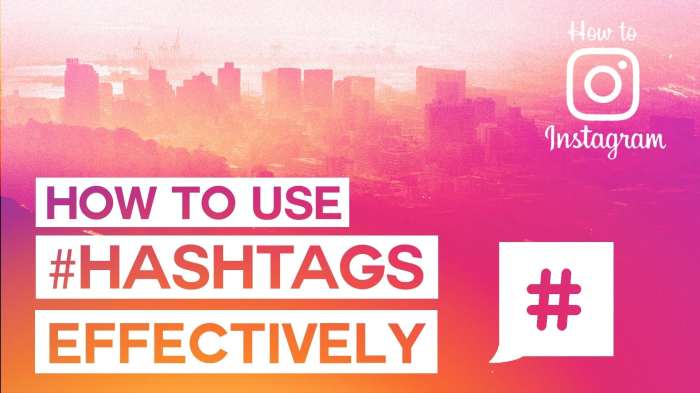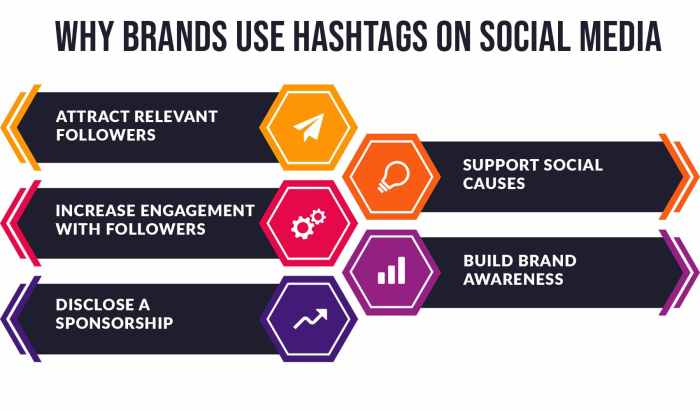Kicking off with Using Hashtags Effectively, this guide will show you how to level up your social media game and reach a wider audience with the power of hashtags. From trending tags to niche-specific gems, get ready to elevate your online presence.
Importance of Hashtags: Using Hashtags Effectively
Hashtags are like the secret sauce for your social media posts, ya know? They help your content get seen by a wider audience and increase engagement like no other. So, let’s dive into why hashtags are so crucial in the social media game.
Increased Visibility and Engagement, Using Hashtags Effectively
When you slap some hashtags on your posts, it’s like waving a flag in a crowded room, shouting “Look at me!” People searching for those hashtags can stumble upon your content even if they don’t follow you. Plus, hashtags can spark conversations and interactions with peeps who share the same interests. It’s like making new friends without even trying, man.
Categorizing Content and Reaching a Wider Audience
By using hashtags, you’re basically organizing your posts into different categories, making it easier for folks to find what they’re looking for. Whether it’s #FoodieFriday or #ThrowbackThursday, hashtags help you connect with people who dig the same stuff you do. And hey, the more eyes on your content, the better, right?
Types of Hashtags
When it comes to hashtags, there are different types that serve various purposes in the social media landscape. Understanding these types can help you effectively reach your target audience and increase engagement.
Branded Hashtags
Branded hashtags are specific to a particular brand or company. They are used to promote brand awareness, campaigns, or events. For example, Nike uses #justdoit to promote its products and inspire customers to take action.
Trending Hashtags
Trending hashtags are popular topics or hashtags that are currently trending on social media platforms. Jumping on these hashtags can help increase visibility and reach a wider audience. For instance, during events like the Super Bowl, brands often use trending hashtags related to the game to join the conversation and increase engagement.
Niche-Specific Hashtags
Niche-specific hashtags are tailored to a specific industry, interest, or community. These hashtags help target a specific audience interested in a particular niche. For example, a fitness influencer may use #fitfam or #gymlife to connect with individuals interested in fitness and health.Choosing the right hashtags is crucial for maximizing the reach and impact of your social media posts. Consider your content and target audience when selecting hashtags to ensure they are relevant and engaging.
By using a combination of branded, trending, and niche-specific hashtags, you can effectively connect with your audience and boost your social media presence.
Best Practices for Using Hashtags

Using hashtags effectively can significantly boost the visibility of your social media posts. Here are some best practices to consider:
Researching Relevant Hashtags
When looking for hashtags to use, it’s essential to research and find those that are relevant to your post. Take the time to explore popular hashtags in your niche and see which ones are commonly used by your target audience.
- Utilize tools like Hashtagify or RiteTag to discover relevant hashtags.
- Look at what hashtags your competitors are using and analyze their effectiveness.
- Consider using a mix of broad and niche-specific hashtags to reach a wider audience.
Optimal Number of Hashtags
The number of hashtags you should use can vary depending on the social media platform. Here are some guidelines to follow:
- Instagram: Aim for around 10-15 hashtags per post to maximize visibility.
- Twitter: Keep it concise with 1-2 relevant hashtags per tweet to avoid overwhelming your audience.
- Facebook: Limit hashtags to 1-2 per post to maintain a clean and professional appearance.
Creating Unique Hashtags
In addition to using existing hashtags, creating unique ones can help your content stand out and build brand recognition. Consider the following tips:
- Make sure your unique hashtag is easy to remember and spell.
- Use your brand name or a catchy slogan as part of the hashtag.
- Promote your unique hashtag across all your social media channels to encourage engagement.
Hashtag Mistakes to Avoid

When using hashtags, it’s important to be mindful of common mistakes that can hinder your social media strategy. By avoiding these pitfalls, you can maximize the impact of your posts and reach a wider audience.
Avoid Irrelevant Hashtags
Using hashtags that are unrelated to your content can confuse your audience and diminish the effectiveness of your post. It’s essential to choose hashtags that are relevant to the topic you are discussing to ensure that you are reaching the right audience.
Avoid Overused Hashtags
Overusing popular hashtags may seem like a good idea to increase visibility, but it can actually have the opposite effect. Your post may get lost in a sea of other posts using the same hashtag, making it harder for your content to stand out. Instead, focus on using niche hashtags that are specific to your content to reach a more targeted audience.
Avoid Hashtag Spamming
Using too many hashtags in a single post can come across as spammy and turn off your followers. It’s best to stick to a few relevant hashtags that enhance your content rather than overwhelming it with an excessive amount. Quality over quantity is key when it comes to using hashtags effectively.
How to Avoid Hashtag Misuse
To avoid making mistakes with hashtags, take the time to research trending and relevant hashtags in your industry. Create a list of hashtags that are tailored to your content and rotate them strategically in your posts. By being intentional with your hashtag usage, you can increase engagement and grow your following organically.
